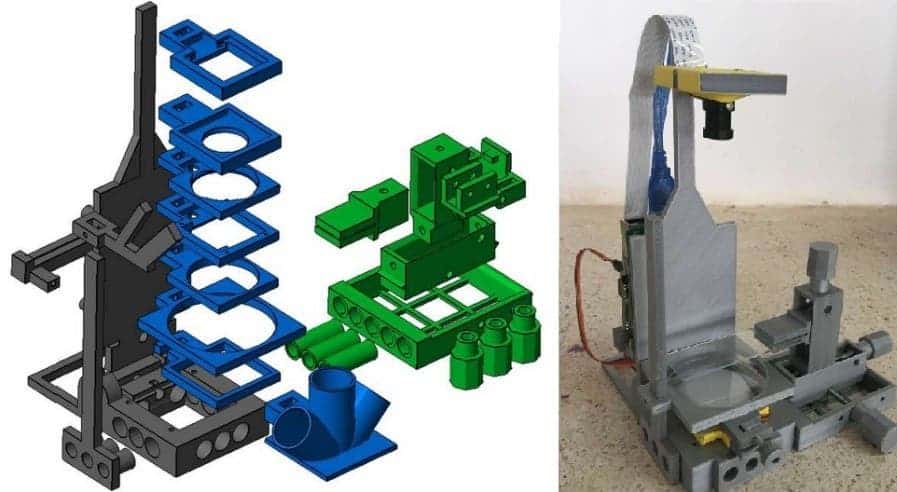Doing science is not cheap at all these days. Many scientists argue that they’re underpaid, and this is true in most parts of the world, but lab equipment expenses weigh even more. Modern instruments like electron scanning microscopes or spectrometers cost tens of thousands of dollars and some are priced in excess of $100k. In developing countries, this huge economic entry barrier means science suffers. With this in mind, a team at the Universities of Tübingen and Sussex have sought to slash lab equipment costs by innovating.

This is a 3-D model of FlyPi (left) and the assembled FlyPi with single micromanipulator and light-emitting diode-ring module, diffusor, and Petri dish adapter mounted in the bottom (right). Credit: Tom Baden.
The researchers presented their concept called ‘FlyPi’ in a recent paper published in PLOS Biology. Essentially, the ‘FlyPi’ is a low-cost imaging and microscope system meant for research, training, and research, particularly in neuroscience.
The design is based on 3-D printed components that form a framework for cheap LEDs for lighting, simple lenses for magnification, a camera for recording, and a Raspberry Pi computer for processing, data storage, and communication with an external device. There are also optical and thermal control circuits based on Arduino, an open-source microcontroller.
When you add everything together, the whole system doesn’t cost more than 100 Euros. What’s more, unlike most cumbersome and expensive lab equipment, the FlyPi can be customized to a lab’s particular needs thanks to the system’s modular approach.
The applications are obviously limited but that doesn’t mean you can’t do proper science with just 100 Euros-worth of lab equipment.
“Many institutions around the world have little money to spend on costly equipment,” said lead researcher Tom Baden from the Universities of Tübingen and Sussex. “We think it is very important that neuroscientific training and research open up to larger numbers of students and junior scientists. So we hope that, with open labware such as our FlyPi, we can offer a starting point.”
We have the Open Source movement to thank for this achievement, which can already boast success in science.
In 2009, for example, Irfan Prijambada, a microbiologist at Gadjah Mada University in Yogyakarta, Indonesia, equipped his lab with tissue-culture hoods and microscopes for less than 10% of their commercial price, using designs posted by a life-sciences-community platform called Hackteria. At the University of Toronto, Canada, researchers developed an open-source platform for doing biology and chemistry on a chip, known as DropBot. On the Open-source Lab page on Appropedia, you can find designs and instruction on how to make various lab equipment on your own from syringe pumps to Raman spectrometers to 3-D printed labware. And if you’re interested, we’ve compiled seven Raspberry Pi projects like a home security system or air quality detector you can assemble by yourself based on simple instructions.
Some scientists, of course, will be skeptical of the DIY approach out of concerns these open source system won’t faithfully produce the validated, standardized performance of commercial lab equipment. Indeed, this is a serious concern. The open hardware community, though enthusiastic, can fail when it comes to offering the proper tools and information so the finished piece behaves the same, whether assembled in a garage in San Francisco or at a university in France or India. In time, these issues will be addressed as the community becomes more coherent. Just look at where the open source software movement is today. You’re likely reading this article on an Android device, which is an open source mobile software made at Google, and the software we use at ZME Science to publish daily is WordPress, an open source platform enjoyed by millions of other bloggers.









